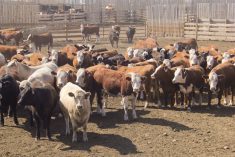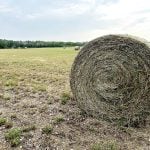U.S. soybean futures reversed three days of declines on Wednesday gaining over one per cent on technical buying and bargain hunting as the dollar weakened.
"The dollar stayed under pressure all day and I think that brought in some bottom-picking or bargain buying," said Sterling Smith, futures strategist for Citigroup.
"There was late technical buying, buy-stops were hit around the $15.02 to $15.03 level and that generated a little additional buying," he said (all figures US$).
Chicago Board of Trade (CBOT) November soybeans were up 15-1/2 cents per bushel at $15.09-1/4 after trading in a wide range of $14.87-1/4 to $15.11-1/4.
Read Also

U.S. livestock: Feeder cattle hit contract highs on tight supply
Chicago | Reuters – All Chicago Mercantile Exchange feeder cattle futures and most live cattle futures hit contract highs on…
Soybeans had plunged 17 per cent to a 3-1/2 month low early in the week from record highs of nearly $18 per bushel set in early September, leaving the market vulnerable to an upside correction.
"I think some were trying to short it under $15 and they covered late when it refused to break," Smith said.
U.S. wheat futures also rose one per cent on the dollar’s weakness and on dryness that posed a threat to wheat fields in Australia and the U.S., the two top global wheat exporters.
Corn was likewise firm, gaining one percent posting advances for the second day in a row, but lacked bullish momentum.
CBOT December wheat was up 8-1/2 cents per bushel at $8.56-1/4 and December corn was up 7-1/4 at $7.45-1/2.
Traders and analysts said investors were reassured by credit rating agency Moody’s decision to maintain Spain’s investment-grade status, pushing the euro to a one-month high against the dollar and giving a boost to commodities traded in the U.S. currency.
"Grains are generally firming above Monday’s lows with the rest of the commodity complex," said Arlan Suderman, senior market analyst for Water Street Advisory.
End-users are being patient, he said, allowing prices to come to them. Meanwhile, the cash basis market is firming as farmers begin to "lock the bin doors" or quit selling corn or soybeans.
"It’s a ‘wait and see’ market of cat and mouse right now with farmers betting that demand still exceeds supply, end-users betting it doesn’t and fund managers generally seeing the current global economic situation as not being conducive for owning commodities," Suderman said.
European wheat futures edged lower on Wednesday as a one-month high for the euro against the dollar offset the influence of a rise in U.S. prices. The active November contract was down 1.50 euros, at 256 euros per tonne.
Weather worries
Dry weather in several key global crop producing regions kept aggressive selling interest away from each market, especially the wheat market since key exporter Australia continues to suffer from very dry wheat conditions.
A Reuters poll of 10 analysts in early October showed Australia’s wheat production at 21.4 million tonnes, down more than one million tonnes from the government’s most recent estimate for 22.5 million. The poll showed wheat output falling 27 per cent from last year’s record crop of 29.5 million as dry weather reduces yields.
In its October crop report, the U.S. Department of Agriculture pegged Australia’s wheat exports for the current 2012-13 marketing year at 18 million tonnes, below the forecast in September for 21 million.
USDA’s October forecast for Australia’s wheat production was 23 million, down from 26 million in September.
U.S. drought fallout
The worst U.S. drought in over 50 years has drawn down soil moisture reserves in the Great Plains hard red winter wheat region. Recent showers, while boosting fall seeding prospects, failed to fully recharge soil moisture levels.
The dry area includes parts of Kansas, the largest U.S. producer of bread making quality hard red winter wheat.
Justin Gilpin, chief executive of the Kansas Wheat Commission, told the Reuters global ag forum on Wednesday that northwest Kansas needs rain.
"Soil moisture profiles are a long ways from where they need to be. We will need Mother Nature to hold the hand of this year’s crop as we don’t have a ‘soil moisture bank’ to draw on this spring," he said.
Much of the U.S. Plains hard red winter wheat area has received sufficient rains to boost wheat seedings and emergence with the exception of a large pocket of dryness in the northwest, said Andy Karst, meteorologist for World Weather Inc.
"It’s still too dry in northwest Kansas, Colorado and Nebraska; they need rain and there is none forecast for those areas," Karst said.
Kansas City Board of Trade hard red winter wheat for December delivery was up 11-1/4 at $8.94.
— Sam Nelson covers the grain markets in Chicago for Reuters. Additional reporting for Reuters by Gus Trompiz in Paris and Naveen Thukral in Singapore.















